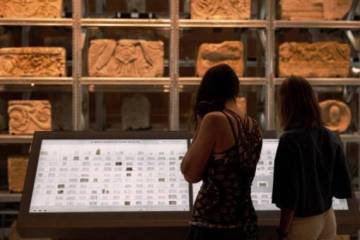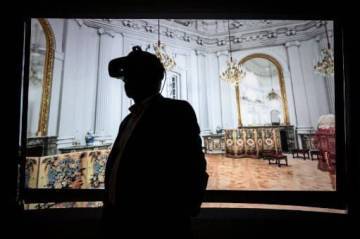The law on museums in France, which entered into force on 4 January 2002, has recast the public policy of museums. The update on the occasion of a day of study for professionals, Monday, December 12 at the Musée d'Orsay.
2022 marks the 20th anniversary of the French Museums Act of 4 January 2002. This text established the designation «Musées de France» which today concerns a network of more than 1,200 institutions throughout the territory, representing all periods and a wide variety of geographical origins of the works.
This law also gives museums the mission to enrich their collections and make them accessible to the widest possible public by diversifying their exhibition proposals, inventing new forms of mediations and inviting digital in their programming.
Several initiatives, at national or regional level, marked this event throughout the year. To conclude these celebrations, the Ministry of Culture organized a day of exchanges 12 December at the Musée d'Orsay in the direction of professionals. With the objective of imagining levers for the future and drawing the outline of the museum of tomorrow. The point with Christelle Creff, Director of the French Museum Service.
On 4 January 2002, the law on «museums of France» came into force. What was the context that justified this law at the time and what are the main thrusts of it?
The genesis of this law is part of a historical context marked by the social and cultural evolution of post-war audiences. Since 1945, museums have been governed by an interim order, but it became necessary to adopt a flexible legislative framework adapted to the new reality of museums. The ambition was to protect a museum heritage on the model of the law of 1913 for historical monuments.
The 2002 law creates the name «museums of France» with four main objectives: the harmonization of the status of museums recognized by the State while respecting their typologies of collections; the strengthening of the protection of collections through the affirmation of the principle of inalienability, while respecting the principle of public ownership; the application of State control and the implementation of its accompaniment to the «museums of France», especially for the writing of scientific and cultural projects (PSC) or the recruitment of qualified staff and finally the structuring dimension of the museum as a service promoting cultural development and democratization by promoting the emergence of public services.
The law defines common obligations for the owners who manage museums, while recognising their ability to manage them, according to their own choices, while respecting the principle of free administration of local authorities. Finally, the law organizes the transfer of the property to the local authorities of the deposits of the State before 1910 and provides for the possibility of transfer of all or part of the collections of one museum of France to another, between public persons.
The territorial dimension is one of the major challenges of this law with the creation of a name «museum of France». How is this dimension taken into account with the law and how has this designation made it possible to better value the territorial collections?
With the “museums” act, it is a unique name that brings together museums benefiting from this new protection. Better identified, they are placed more directly under the gaze of the Regional Directorates of Cultural Affairs (DRAC), particularly with regard to any decision to acquire cultural property: where previously the so-called «classified» and «controlled» museums had to present their proposed acquisition to an artistic council meeting in Paris, a new advisory body, a regional scientific commission, gives its opinion on the proposed acquisition.
These commissions, organized by each DRAC, were conceived as places of exchange between professionals, some from the region itself. They benefit very quickly from the pedagogical work carried out on the ground by the advisors for the museums of the DRAC, but also from the rise in power of the professionals of museums (curators, conservation officers) more numerous to be from the competitions, to which is added the increasing consideration by elected officials of the importance of their heritage, vector of tourist attractiveness and therefore economic.
With the incentive for the «museums of France» to have a public service, the teams will specialize and help create, in the territories, museums better able to present and enhance their collections. More numerous exhibitions, more innovative, and more accessible to all audiences have made it possible to give back to the territories that took hold of them an image of modernity and proximity. A strengthened dialogue between museums and State departments has facilitated the implementation of the transfers of ownership of State repositories prior to 1910 mentioned above, which has given museums greater freedom to manage their collections.
In what and how do the «museums of France» form a network and how does this materialize?
The “museums of France” rely on professionals (curators, attachés, stage managers, mediators, restorers, etc.) acting together to serve the same policy: the conservation, enrichment and enhancement of the collections for which they are responsible. Driven by a common goal, a common passion, these actors at the service of cultural property share values, principles and ethics that naturally contribute to «making community»: the network of «museums of France».
In addition, each one, depending on his specialty, the identity of the museum or the collections he manages, also contributes to professional or scientific networks, places for sharing best practices, feedback, promotion of professions. As we can see, it is appropriate, in practice, to speak less “of” the network of “museums of France” than “of” the networks of “museums of France”. The Directorate-General for Heritage and Architecture, within the framework of its scientific and technical control, endeavours to make these networks known and grow. It historically subsidizes some of them and ensures as far as possible a presence on the occasion of professional days that they organize or by organizing itself a day of study each year to carry the voice of the State and contribute, at its level, to irrigate the «museums of France».
The Scientific and Cultural Project (PSC), the first operational and strategic document that defines the identity and orientations of the museum, is provided for by the 2002 law but was not made mandatory for all «museums of France» until 2016. What is it used for and how have museums used it to better accommodate their audiences?
With the wave of major museum renovation projects in the 1980s, it became necessary to provide institutions with operational and forward-looking roadmaps on which to build to implement such operations. Thus the notion of scientific and cultural project has gradually developed into a useful and necessary tool for museum governance.
Its role is to define the identity and the broad orientations that each institution wishes to take, not only in terms of collections, their backgrounds, but also of the building or the policies of the public to be led. If the PSC is a forward-looking document, it is based on an inventory and a history: it cannot ignore the sometimes ancient past of the museum institution, its place in a territory, how the museum has evolved in its organization and in its staff. Because it defines the policy of the institution, the PSC is a document made to be shared with all the actors (staff, elected officials, architects, etc.), so that everyone appropriates it to build a common project that is embodied in the scientific and cultural actions it defines.
The Museums Act of 2002 reaffirmed the missions of cultural dissemination of museums and the central place that the public occupies there. An important part of the CSP is of course devoted to this by considering the diversity and plurality of its potential visitors. It is also a reflection of contemporary issues in society, addressing in particular the issues of sustainable development that the network of «museums of France» is addressing in order to become more resilient.
Over the past 20 years, the relationship with audiences has become a real issue for museums
How has this law contributed to the professionalization of museum professions?
This law created a common foundation of professional requirements to ensure a certain quality of the scientific and cultural proposal of the institutions. This code of shared values unifies the strategies, objectives and means implemented by the “museums of France”, which include all specialties (museums of fine arts, history, society, archaeology, science and technology, natural history museums).
A net change in practices was observed, on the one hand, with the establishment of the scientific and cultural project (PSC) and, on the other hand, through the management of collections. The acquisition and restoration processes were structured with the creation of specific scientific commissions, designed as places of exchange between professionals. The evolution and structuring of the operation of the «museums of France» has also consisted in taking into account new issues such as preventive conservation, collections sites, as well as the ten-year document set up with the 2002 law.
This professionalization of museum professions complemented the regulatory training already put in place to be able to recruit state-authorized scientific staff: before 2002, the National Heritage Institute (INP) proposed to recruit and train future conservators and restaurateurs.
Finally, the law on «museums of France» has encouraged professionalization in cultural mediation, since every «museum of France» must have a public service and therefore qualified cultural mediators.
Precisely, over the past 20 years or so, the relationship with audiences has become a real issue for museums, as evidenced by the place taken by cultural mediation, digital or arts and cultural education… How has the Museums Act fostered this dimension and made the collections accessible to the wider public?
Before the law on «museums of France», the 1945 ordinance focused mainly on pedagogical action. The 2002 act broadens these issues by pushing for the creation of real public services. It therefore acts as an institutional recognition of the need to involve the population in developing a museum policy.
With a view to cultural democratization, many institutions try to make the museum a welcoming place where visitors want to come, and especially to return. This includes integrating societal and citizen issues at the heart of museum programming. Following the 2002 law, co-construction projects have multiplied: the audiences of the institutions participate in the organization of temporary exhibitions, but also in other museum missions. The report of the mission on museums of XXIe century (2016-2017) insisted again. And, in fact, we see that sustainable development and issues of parity are now systematically included in the scientific and cultural project or give rise to the organization of specific events.
Similarly, to foster relationships with audiences, museums have increasingly relied on digital technology, particularly during the Covid-19 crisis. Audiovisual tools enrich the mediation of collections. In addition, museums are now using other means such as podcasts or social networks, as was the case for European Nights of Museums in 2020 and 2021.






